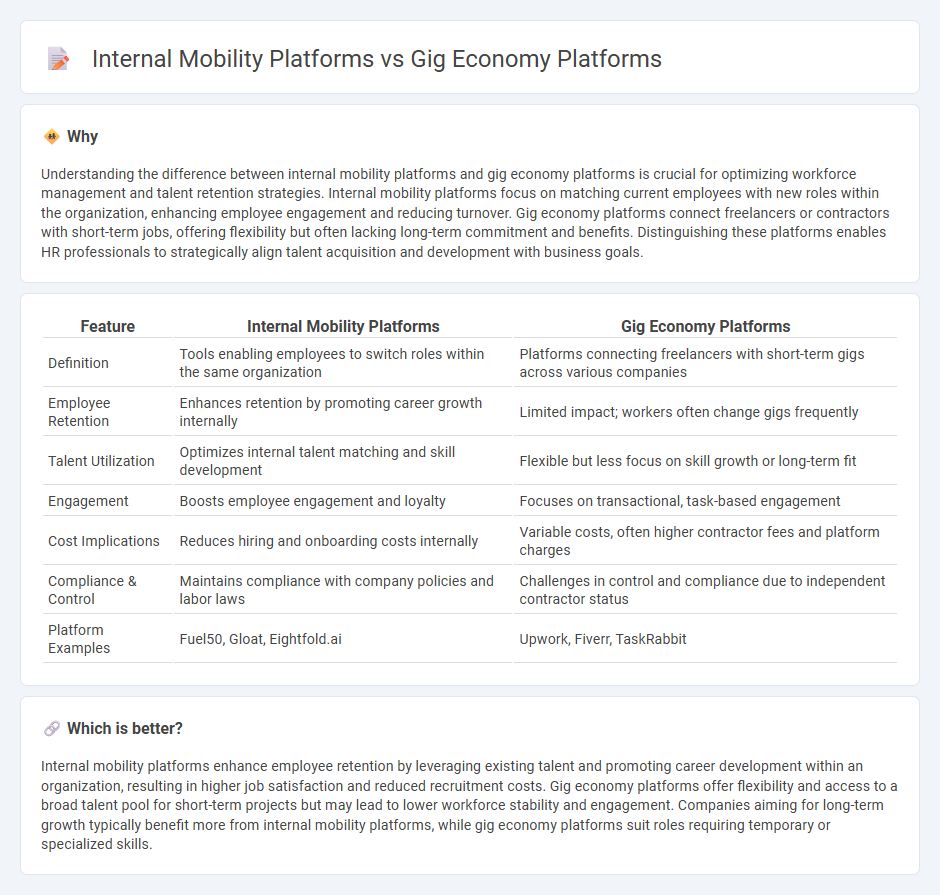
Internal mobility platforms enhance employee retention by matching existing talent with new roles within the organization, fostering career growth and organizational knowledge retention. Gig economy platforms, by contrast, offer flexible, short-term work arrangements, tapping into a vast external talent pool but often lacking continuity and long-term engagement. Discover how leveraging these platforms can optimize workforce strategy and business agility.
Why it is important
Understanding the difference between internal mobility platforms and gig economy platforms is crucial for optimizing workforce management and talent retention strategies. Internal mobility platforms focus on matching current employees with new roles within the organization, enhancing employee engagement and reducing turnover. Gig economy platforms connect freelancers or contractors with short-term jobs, offering flexibility but often lacking long-term commitment and benefits. Distinguishing these platforms enables HR professionals to strategically align talent acquisition and development with business goals.
Comparison Table
| Feature | Internal Mobility Platforms | Gig Economy Platforms |
|---|---|---|
| Definition | Tools enabling employees to switch roles within the same organization | Platforms connecting freelancers with short-term gigs across various companies |
| Employee Retention | Enhances retention by promoting career growth internally | Limited impact; workers often change gigs frequently |
| Talent Utilization | Optimizes internal talent matching and skill development | Flexible but less focus on skill growth or long-term fit |
| Engagement | Boosts employee engagement and loyalty | Focuses on transactional, task-based engagement |
| Cost Implications | Reduces hiring and onboarding costs internally | Variable costs, often higher contractor fees and platform charges |
| Compliance & Control | Maintains compliance with company policies and labor laws | Challenges in control and compliance due to independent contractor status |
| Platform Examples | Fuel50, Gloat, Eightfold.ai | Upwork, Fiverr, TaskRabbit |
Which is better?
Internal mobility platforms enhance employee retention by leveraging existing talent and promoting career development within an organization, resulting in higher job satisfaction and reduced recruitment costs. Gig economy platforms offer flexibility and access to a broad talent pool for short-term projects but may lead to lower workforce stability and engagement. Companies aiming for long-term growth typically benefit more from internal mobility platforms, while gig economy platforms suit roles requiring temporary or specialized skills.
Connection
Internal mobility platforms and gig economy platforms share a focus on flexible talent allocation, enabling organizations to optimize workforce utilization by connecting employees with short-term projects or roles within or outside the company. Both leverage digital technologies and data analytics to match skill sets with demand in real-time, enhancing workforce agility and employee engagement. This integration supports continuous talent development and addresses fluctuating business needs by promoting dynamic job assignments and project-based collaborations.
Key Terms
Flexibility (Gig Economy Platforms)
Gig economy platforms offer unmatched flexibility by allowing workers to choose projects, set their own hours, and work from anywhere, accommodating varying personal schedules and preferences. Internal mobility platforms provide flexibility by enabling employees to explore diverse roles within the organization without leaving the company, fostering career growth and job satisfaction. Explore how these platforms can transform your workforce dynamics and boost engagement.
Talent Retention (Internal Mobility Platforms)
Internal mobility platforms enhance talent retention by enabling employees to discover new opportunities within the organization, fostering career growth and job satisfaction. These platforms leverage AI-driven talent matching and skills mapping to align employee potential with evolving business needs, reducing turnover costs and improving workforce agility. Explore how internal mobility platforms transform talent retention strategies by unlocking hidden potential and promoting organizational loyalty.
Workforce Management
Workforce management in gig economy platforms relies heavily on algorithm-driven task allocation and real-time worker availability, optimizing flexibility and scalability for businesses. Internal mobility platforms prioritize employee development through data-driven skills mapping and career pathing, enhancing retention and internal talent utilization. Explore how integrating these platforms can revolutionize your workforce strategy.
Source and External Links
10 Best Gig Economy Companies To Choose in 2025 - Native Teams - This article lists top gig economy platforms including Uber Eats, Airbnb, and TaskRabbit, highlighting their services in food delivery, lodging, and local task markets where gig workers can find flexible work opportunities using their own skills or assets.
12 Best gig economy platforms for your side hustle - Featuring the best platforms like Fiverr, Upwork, and Prospa, this source emphasizes freelance digital work, remote jobs, and other side hustles that allow individuals to connect globally and earn through diverse gig roles.
The Best Gig Work Websites in 2025 - Upwork - Provides a categorized list of gig platforms by service type such as on-demand services (Uber, Lyft, DoorDash), and creative work (Medium, Contently), illustrating the variety and specialization of gig economy websites tailored to different types of gig workers.
 dowidth.com
dowidth.com